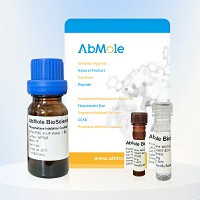All AbMole products are for research use only, cannot be used for human consumption.

PACAP (1-38) is a highly potent PACAP receptor agonist (Kd = 100 pM), it stimulates adenylate cyclase and phagocytosis. PACAP (1-38) dramatically prevents injury of cultured renal proximal tubule cells caused by myeloma light chains through suppression of proinflammatory cytokines production, by inhibiting p38 MAPK and translocation of NFκB via both PAC1 and VPAC1 receptors. PACAP (1-38) inhibits myeloma cell growth directly and may also indirectly by suppressing production of the growth factor, IL-6, from bone marrow stromal cells, that is stimulated by adhesion of myeloma cells.
Sequence: His-Ser-Asp-Gly-Ile-Phe-Thr-Asp-Ser-Tyr-Ser-Arg-Tyr-Arg-Lys-Gln-Met-Ala-Val-Lys-Lys-Tyr-Leu-Ala-Ala-Val-Leu-Gly-Lys-Arg-Tyr-Lys-Gln-Arg-Val-Lys-Asn-Lys-NH2
| Molecular Weight | 4534.26 |
| Formula | C203H331N63O53S1 |
| CAS Number | 137061-48-4 |
| Solubility (25°C) | Water 100 mg/mL |
| Storage | -20°C, sealed |
| Related Peptides Products |
|---|
| TMTP1 Peptide
TMTP1 is a 5-amino acid peptide NVVRQ, it can be used for the labeling of malignant in situ and metastatic lesions, and even micro-metastases. TMTP1 specifically bound to the cells of a series of hematological malignancies, including HL60, k562, Jurkat, Raji, El-4 and chronic myeloid leukemia primary cells but not to bone marrow mononuclear cells from healthy subjects. TMTP1, as a novel tumor-homing peptide, can serve as a marker for primary malignant and metastatic lesions. |
| Amylin amide, human TFA
Amylin amide, human TFA is a 37-amino acid polypeptide, it is a pancreatic hormone cosecreted with insulin that exerts unique roles in metabolism and glucose homeostasis. Amylin amide, human TFA inhibits glucagon secretion, delays gastric emptying. |
| WL47 TFA
WL47 TFA, a high-affinity cavolin-1 (CAV1) ligand (Kd=23 nM), is a potent disrupter of CAV1 oligomers. WL47 TFA shows selectivity for CAV1 over BSA, casein and HEWL. WL47 TFA can be used for the study of caveolin-1 function. |
| Angiopep-2-Cys TFA
Angiopep-2-cys is a conjugate of Angiopep-2 hydrochloride and cysteine. The conjugation of anticancer agents with the Angiopep-2 peptide vector could increase their efficacy in the treatment of brain cancer. |
| H3K4(Me2) (1-20)
H3K4(Me2) (1-20) is a histone peptide. H3K4me2 regulates the recovery of protein biosynthesis and homeostasis following DNA damage. |
All AbMole products are for research use only, cannot be used for human consumption or veterinary use. We do not provide products or services to individuals. Please comply with the intended use and do not use AbMole products for any other purpose.


Products are for research use only. Not for human use. We do not sell to patients.
© Copyright 2010-2024 AbMole BioScience. All Rights Reserved.
